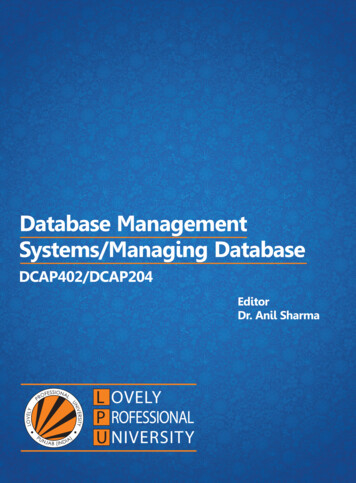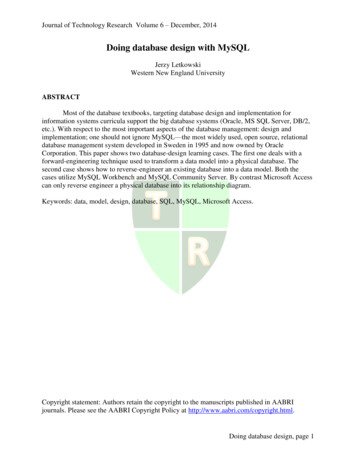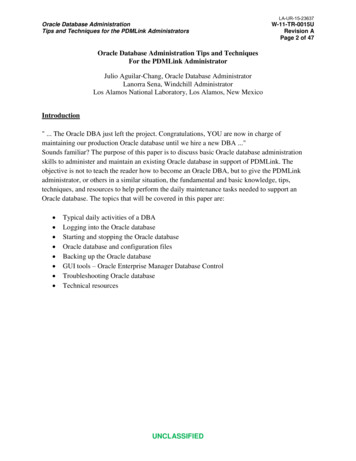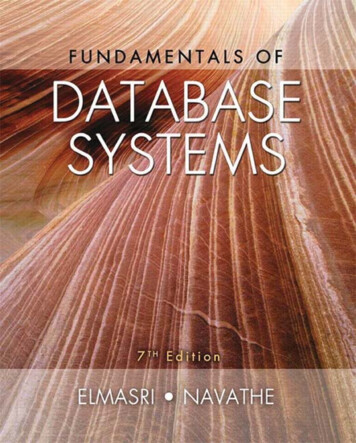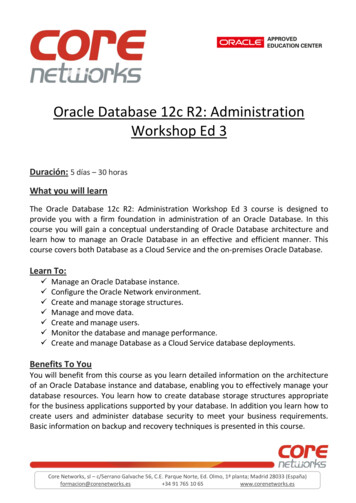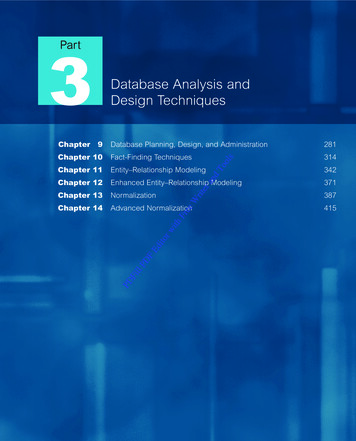
Transcription
Part3ChapterDatabase Analysis andDesign Techniques9281Chapter 10Fact-Finding Techniques314Chapter 11Entity–Relationship ModelingChapter 12Enhanced Entity–Relationship ModelingChapter 13NormalizationChapter 14Advanced Database Planning, Design, and Administration342371387415
PDFillFPDithEditorwFreeerritWoolsdTan
Chapter9Database Planning,Design, and AdministrationChapter ObjectivesoolsIn this chapter you will learn:The main components of an information system.nThe main stages of the database system development lifecycle (DSDLC).nThe main phases of database design: conceptual, logical, and physical design.nThe benefits of Computer-Aided Software Engineering (CASE) tools.nThe types of criteria used to evaluate a DBMS.nHow to evaluate and select a DBMS.nThe distinction between data administration and database administration.nThe purpose and tasks associated with data administration and dTnPDFiSoftware has now surpassed hardware as the key to the success of many computerbased systems. Unfortunately, the track record at developing software is not particularlyimpressive. The last few decades have seen the proliferation of software applicationsranging from small, relatively simple applications consisting of a few lines of code,to large, complex applications consisting of millions of lines of code. Many of theseapplications have required constant maintenance. This involved correcting faults thathad been detected, implementing new user requirements, and modifying the software torun on new or upgraded platforms. The effort spent on maintenance began to absorbresources at an alarming rate. As a result, many major software projects were late, overbudget, unreliable, difficult to maintain, and performed poorly. This led to what hasbecome known as the software crisis. Although this term was first used in the late 1960s,more than 40 years later the crisis is still with us. As a result, some authors now referto the software crisis as the software depression. As an indication of the crisis, a studycarried out in the UK by OASIG, a Special Interest Group concerned with the Organizational Aspects of IT, reached the following conclusions about software projects(OASIG, 1996):
Chapter 9 z Database Planning, Design, and Administrationn80–90% do not meet their performance goals;nabout 80% are delivered late and over budget;naround 40% fail or are abandoned;nunder 40% fully address training and skills requirements;nless than 25% properly integrate enterprise and technology objectives;njust 10–20% meet all their success criteria.There are several major reasons for the failure of software projects including:nlack of a complete requirements specification;nlack of an appropriate development methodology;npoor decomposition of design into manageable components.FreeWriterandToolsAs a solution to these problems, a structured approach to the development of softwarewas proposed called the Information Systems Lifecycle (ISLC) or the SoftwareDevelopment Lifecycle (SDLC). However, when the software being developed is adatabase system the lifecycle is more specifically referred to as the Database SystemDevelopment Lifecycle (DSDLC).EditorwithStructure of this ChapterPDFIn Section 9.1 we briefly describe the information systems lifecycle and discuss howthis lifecycle relates to the database system development lifecycle. In Section 9.2 we present an overview of the stages of the database system development lifecycle. In Sections9.3 to 9.13 we describe each stage of the lifecycle in more detail. In Section 9.14 we discuss how Computer-Aided Software Engineering (CASE) tools can provide support forthe database system development lifecycle. We conclude in Section 9.15 with a discussionon the purpose and tasks associated with data administration and database administrationwithin an organization.ll PDFi2829.1The Information Systems LifecycleInformationsystemThe resources that enable the collection, management, control, anddissemination of information throughout an organization.Since the 1970s, database systems have been gradually replacing file-based systems as partof an organization’s Information Systems (IS) infrastructure. At the same time there has
9.2 The Database System Development LifecycleithFreeWriterandToolsbeen a growing recognition that data is an important corporate resource that should betreated with respect, like all other organizational resources. This resulted in many organizations establishing whole departments or functional areas called Data Administration(DA) and Database Administration (DBA), which are responsible for the management andcontrol of the corporate data and the corporate database, respectively.A computer-based information system includes a database, database software, application software, computer hardware, and personnel using and developing the system.The database is a fundamental component of an information system, and its development and usage should be viewed from the perspective of the wider requirements of theorganization. Therefore, the lifecycle of an organization’s information system is inherentlylinked to the lifecycle of the database system that supports it. Typically, the stages in thelifecycle of an information system include: planning, requirements collection and analysis,design, prototyping, implementation, testing, conversion, and operational maintenance.In this chapter we review these stages from the perspective of developing a database system. However, it is important to note that the development of a database system shouldalso be viewed from the broader perspective of developing a component part of the largerorganization-wide information system.Throughout this chapter we use the terms ‘functional area’ and ‘application area’ torefer to particular enterprise activities within an organization such as marketing, personnel,and stock control.EditorwThe Database System DevelopmentLifecyclePDFillPDFAs a database system is a fundamental component of the larger organization-wideinformation system, the database system development lifecycle is inherently associatedwith the lifecycle of the information system. The stages of the database system development lifecycle are shown in Figure 9.1. Below the name of each stage is the section in thischapter that describes that stage.It is important to recognize that the stages of the database system development lifecycle are not strictly sequential, but involve some amount of repetition of previous stagesthrough feedback loops. For example, problems encountered during database design maynecessitate additional requirements collection and analysis. As there are feedback loopsbetween most stages, we show only some of the more obvious ones in Figure 9.1. A summary of the main activities associated with each stage of the database system developmentlifecycle is described in Table 9.1.For small database systems, with a small number of users, the lifecycle need not bevery complex. However, when designing a medium to large database systems with tens tothousands of users, using hundreds of queries and application programs, the lifecycle canbecome extremely complex. Throughout this chapter we concentrate on activities associated with the development of medium to large database systems. In the following sectionswe describe the main activities associated with each stage of the database system development lifecycle in more detail.9.2 283
oolsdTanerritWFreeithEditorwFPDllPDFiFigure 9.1 The stages of the database system development lifecycle.
9.3 Database PlanningTable 9.1 Summary of the main activities associated with each stage of the databasesystem development lifecycle.Main activitiesDatabase planningPlanning how the stages of the lifecycle can be realized mostefficiently and effectively.Specifying the scope and boundaries of the database system,including the major user views, its users, and application areas.Collection and analysis of the requirements for the newdatabase system.Conceptual, logical, and physical design of the database.Selecting a suitable DBMS for the database system.Designing the user interface and the application programs thatuse and process the database.Building a working model of the database system, whichallows the designers or users to visualize and evaluate how thefinal system will look and function.Creating the physical database definitions and the applicationprograms.Loading data from the old system to the new system and,where possible, converting any existing applications to run onthe new database.Database system is tested for errors and validated against therequirements specified by the users.Database system is fully implemented. The system iscontinuously monitored and maintained. When necessary, newrequirements are incorporated into the database system throughthe preceding stages of the lifecycle.System definitionRequirements collectionand analysisDatabase designDBMS selection (optional)Application designandTPrototyping (optional)oolsStageWFreeData conversion and loadingriterImplementationPDFillPDFOperational maintenanceEditorwithTestingDatabase PlanningDatabaseplanningThe management activities that allow the stages of the database system development lifecycle to be realized as efficiently and effectively aspossible.Database planning must be integrated with the overall IS strategy of the organization.There are three main issues involved in formulating an IS strategy, which are:nnnidentification of enterprise plans and goals with subsequent determination of information systems needs;evaluation of current information systems to determine existing strengths andweaknesses;appraisal of IT opportunities that might yield competitive advantage.9.3 285
Chapter 9 z Database Planning, Design, and AdministrationPDFEditorwithFreeWriterandToolsThe methodologies used to resolve these issues are outside the scope of this book; however, the interested reader is referred to Robson (1997) for a fuller discussion.An important first step in database planning is to clearly define the mission statementfor the database system. The mission statement defines the major aims of the databasesystem. Those driving the database project within the organization (such as the Directorand/or owner) normally define the mission statement. A mission statement helps to clarifythe purpose of the database system and provide a clearer path towards the efficient andeffective creation of the required database system. Once the mission statement is defined,the next activity involves identifying the mission objectives. Each mission objectiveshould identify a particular task that the database system must support. The assumption isthat if the database system supports the mission objectives then the mission statementshould be met. The mission statement and objectives may be accompanied with someadditional information that specifies, in general terms, the work to be done, the resourceswith which to do it, and the money to pay for it all. We demonstrate the creation of amission statement and mission objectives for the database system of DreamHome inSection 10.4.2.Database planning should also include the development of standards that govern howdata will be collected, how the format should be specified, what necessary documentationwill be needed, and how design and implementation should proceed. Standards can be verytime-consuming to develop and maintain, requiring resources to set them up initially, andto continue maintaining them. However, a well-designed set of standards provides a basisfor training staff and measuring quality control, and can ensure that work conforms to apattern, irrespective of staff skills and experience. For example, specific rules may governhow data items can be named in the data dictionary, which in turn may prevent bothredundancy and inconsistency. Any legal or enterprise requirements concerning the datashould be documented, such as the stipulation that some types of data must be treatedconfidentially.9.4ll System DefinitionPDFi286SystemdefinitionDescribes the scope and boundaries of the database application andthe major user views.Before attempting to design a database system, it is essential that we first identifythe boundaries of the system that we are investigating and how it interfaces with otherparts of the organization’s information system. It is important that we include withinour system boundaries not only the current users and application areas, but also futureusers and applications. We present a diagram that represents the scope and boundariesof the DreamHome database system in Figure 10.10. Included within the scope andboundary of the database system are the major user views that are to be supported by thedatabase.
9.4 System DefinitionUser ViewsUser view 2879.4.1Defines what is required of a database system from the perspectiveof a particular job role (such as Manager or Supervisor) or enterpriseapplication area (such as marketing, personnel, or stock control).PDFillPDFEditorwithFreeWriterandToolsA database system may have one or more user views. Identifying user views is an important aspect of developing a database system because it helps to ensure that no majorusers of the database are forgotten when developing the requirements for the new databasesystem. User views are also particularly helpful in the development of a relatively complex database system by allowing the requirements to be broken down into manageablepieces.A user view defines what is required of a database system in terms of the data to beheld and the transactions to be performed on the data (in other words, what the users willdo with the data). The requirements of a user view may be distinct to that view or overlapwith other views. Figure 9.2 is a diagrammatic representation of a database system withmultiple user views (denoted user view 1 to 6). Note that whereas user views (1, 2, and 3)and (5 and 6) have overlapping requirements (shown as hatched areas), user view 4 hasdistinct requirements.Figure 9.2Representation of adatabase systemwith multiple userviews: user views(1, 2, and 3) and(5 and 6) haveoverlappingrequirements(shown as hatchedareas), whereas userview 4 has distinctrequirements.
Chapter 9 z Database Planning, Design, and AdministrationRequirements Collection and AnalysisRequirementscollection andanalysisThe process of collecting and analyzing information about thepart of the organization that is to be supported by the databasesystem, and using this information to identify the requirements forthe new system.This stage involves the collection and analysis of information about the part of theenterprise to be served by the database. There are many techniques for gathering thisinformation, called fact-finding techniques, which we discuss in detail in Chapter 10.Information is gathered for each major user view (that is, job role or enterprise applicationarea), including:anna description of the data used or generated;the details of how data is to be used or generated;any additional requirements for the new database system.oolsndTnFEditorwithFreeWriterThis information is then analyzed to identify the requirements (or features) to be includedin the new database system. These requirements are described in documents collectivelyreferred to as requirements specifications for the new database system.Requirements collection and analysis is a preliminary stage to database design. Theamount of data gathered depends on the nature of the problem and the policies of the enterprise. Too much study too soon leads to paralysis by analysis. Too little thought can resultin an unnecessary waste of both time and money due to working on the wrong solution tothe wrong problem.The information collected at this stage may be poorly structured and include someinformal requests, which must be converted into a more structured statement of requirements. This is achieved using requirements specification techniques, which include forexample: Structured Analysis and Design (SAD) techniques, Data Flow Diagrams (DFD),and Hierarchical Input Process Output (HIPO) charts supported by documentation. Aswe will see shortly, Computer-Aided Software Engineering (CASE) tools may provideautomated assistance to ensure that the requirements are complete and consistent. InSection 25.7 we will discuss how the Unified Modeling Language (UML) supportsrequirements collection and analysis.Identifying the required functionality for a database system is a critical activity, as systemswith inadequate or incomplete functionality will annoy the users, which may lead to rejectionor underutilization of the system. However, excessive functionality can also be problematicas it can overcomplicate a system making it difficult to implement, maintain, use, or learn.Another important activity associated with this stage is deciding how to deal with thesituation where there is more than one user view for the database system. There are threemain approaches to managing the requirements of a database system with multiple userviews, namely:PD9.5ll PDFi288nnnthe centralized approach;the view integration approach;a combination of both approaches.
WriterandTools9.5 Requirements Collection and AnalysisithFreeFigure 9.3 The centralized approach to managing multiple user views 1 to 3.9.5.1PDFRequirements for each user view are merged into a single set ofrequirements for the new database system. A data model representing all user views is created during the database design stage.PDFillCentralizedapproachEditorwCentralized ApproachThe centralized (or one-shot) approach involves collating the requirements for different user views into a single list of requirements. The collection of user views is givena name that provides some indication of the functional area covered by all the mergeduser views. In the database design stage (see Section 9.6), a global data model is created,which represents all user views. The global data model is composed of diagrams anddocumentation that formally describe the data requirements of the users. A diagram representing the management of user views 1 to 3 using the centralized approach is shown inFigure 9.3. Generally, this approach is preferred when there is a significant overlap inrequirements for each user view and the database system is not overly complex.View Integration ApproachViewintegrationapproachRequirements for each user view remain as separate lists. Data modelsrepresenting each user view are created and then merged later duringthe database design stage.9.5.2 289
Chapter 9 z Database Planning, Design, and e 9.4The view integrationapproach tomanaging multipleuser views 1 to 3.The view integration approach involves leaving the requirements for each user view asseparate lists of requirements. In the database design stage (see Section 9.6), we firstcreate a data model for each user view. A data model that represents a single user view(or a subset of all user views) is called a local data model. Each model is composed ofdiagrams and documentation that formally describes the requirements of one or more butnot all user views of the database. The local data models are then merged at a later stageof database design to produce a global data model, which represents all user requirementsfor the database. A diagram representing the management of user views 1 to 3 using theview integration approach is shown in Figure 9.4. Generally, this approach is preferredll PDFi290
9.6 Database DesigndToolswhen there are significant differences between user views and the database system issufficiently complex to justify dividing the work into more manageable parts. We demonstrate how to use the view integration approach in Chapter 16, Step 2.6.For some complex database systems it may be appropriate to use a combination of boththe centralized and view integration approaches to manage multiple user views. For example,the requirements for two or more user views may be first merged using the centralizedapproach, which is used to build a local logical data model. This model can then be mergedwith other local logical data models using the view integration approach to produce aglobal logical data model. In this case, each local logical data model represents the requirements of two or more user views and the final global logical data model represents therequirements of all user views of the database system.We discuss how to manage multiple user views in more detail in Section 10.4.4 andusing the methodology described in this book we demonstrate how to build a database forthe DreamHome property rental case study using a combination of both the centralized andview integration approaches.9.6FreeThe process of creating a design that will support the enterprise’smission statement and mission objectives for the required abase DesignPDFillPDFIn this section we present an overview of the main approaches to database design. We alsodiscuss the purpose and use of data modeling in database design. We then describe thethree phases of database design, namely conceptual, logical, and physical design.Approaches to Database DesignThe two main approaches to the design of a database are referred to as ‘bottom-up’ and‘top-down’. The bottom-up approach begins at the fundamental level of attributes (thatis, properties of entities and relationships), which through analysis of the associationsbetween attributes, are grouped into relations that represent types of entities and relationships between entities. In Chapters 13 and 14 we discuss the process of normalization,which represents a bottom-up approach to database design. Normalization involves theidentification of the required attributes and their subsequent aggregation into normalizedrelations based on functional dependencies between the attributes.The bottom-up approach is appropriate for the design of simple databases with arelatively small number of attributes. However, this approach becomes difficult whenapplied to the design of more complex databases with a larger number of attributes, whereit is difficult to establish all the functional dependencies between the attributes. As the conceptual and logical data models for complex databases may contain hundreds to thousands9.6.1 291
Chapter 9 z Database Planning, Design, and AdministrationFreeWriterandToolsof attributes, it is essential to establish an approach that will simplify the design process.Also, in the initial stages of establishing the data requirements for a complex database, itmay be difficult to establish all the attributes to be included in the data models.A more appropriate strategy for the design of complex databases is to use the top-downapproach. This approach starts with the development of data models that contain a fewhigh-level entities and relationships and then applies successive top-down refinements toidentify lower-level entities, relationships, and the associated attributes. The top-downapproach is illustrated using the concepts of the Entity–Relationship (ER) model,beginning with the identification of entities and relationships between the entities,which are of interest to the organization. For example, we may begin by identifying theentities PrivateOwner and PropertyForRent, and then the relationship between these entities,PrivateOwner Owns PropertyForRent, and finally the associated attributes such as PrivateOwner(ownerNo, name, and address) and PropertyForRent (propertyNo and address). Building a highlevel data model using the concepts of the ER model is discussed in Chapters 11 and 12.There are other approaches to database design such as the inside-out approach and themixed strategy approach. The inside-out approach is related to the bottom-up approachbut differs by first identifying a set of major entities and then spreading out to considerother entities, relationships, and attributes associated with those first identified. The mixedstrategy approach uses both the bottom-up and top-down approach for various parts of themodel before finally combining all parts together.Editorwith9.6.2 Data ModelingPDFThe two main purposes of data modeling are to assist in the understanding of the meaning(semantics) of the data and to facilitate communication about the information requirements. Building a data model requires answering questions about entities, relationships, andattributes. In doing so, the designers discover the semantics of the enterprise’s data,which exist whether or not they happen to be recorded in a formal data model. Entities,relationships, and attributes are fundamental to all enterprises. However, their meaningmay remain poorly understood until they have been correctly documented. A data modelmakes it easier to understand the meaning of the data, and thus we model data to ensurethat we understand:ll PDFi292nnneach user’s perspective of the data;the nature of the data itself, independent of its physical representations;the use of data across user views.Data models can be used to convey the designer’s understanding of the informationrequirements of the enterprise. Provided both parties are familiar with the notation usedin the model, it will support communication between the users and designers. Increasingly, enterprises are standardizing the way that they model data by selecting a particularapproach to data modeling and using it throughout their database development projects.The most popular high-level data model used in database design, and the one we usein this book, is based on the concepts of the Entity–Relationship (ER) model. We describeEntity–Relationship modeling in detail in Chapters 11 and 12.
9.6 Database DesignTable 9.2The criteria to produce an optimal data model.Structural resentationConsistency with the way the enterprise defines and organizes information.Ease of understanding by IS professionals and non-technical users.Ability to distinguish between different data, relationships between data,and constraints.Exclusion of extraneous information; in particular, the representation ofany one piece of information exactly once.Not specific to any particular application or technology and thereby usableby many.Ability to evolve to support new requirements with minimal effect onexisting users.Consistency with the way the enterprise uses and manages information.Ability to represent a model using an easily understood diagrammaticnotation.anCriteria for data modelsEditorwithFreeWriterAn optimal data model should satisfy the criteria listed in Table 9.2 (Fleming and VonHalle, 1989). However, sometimes these criteria are not compatible with each other andtradeoffs are sometimes necessary. For example, in attempting to achieve greater expressibility in a data model, we may lose simplicity.Phases of Database DesignPDFillPDFDatabase design is made up of three main phases, namely conceptual, logical, and physicaldesign.Conceptual database designConceptualdatabase designThe process of constructing a model of the data used in anenterprise, independent of all physical considerations.The first phase of database design is called conceptual database design, and involvesthe creation of a conceptual data model of the part of the enterprise that we are interestedin modeling. The data model is built using the information documented in the users’requirements specification. Conceptual database design is entirely independent of implementation details such as the target DBMS software, application programs, programminglanguages, hardware platform, or any other physical considerations. In Chapter 15, wepresent a practical step-by-step guide on how to perform conceptual database design.Throughout the process of developing a conceptual data model, the model is tested andvalidated against the users’ requirements. The conceptual data model of the enterprise is asource of information for the next phase, namely logical database design.9.6.3 293
Chapter 9 z Database Planning, Design, and AdministrationLogical database designLogicaldatabasedesignThe process of constructing a model of the data used in an enterprisebased on a specific data model, but independent of a particular DBMSand other physical considerations.PDFEditorwithFreeWriterandToolsThe second phase of database design is called logical database design, which resultsin the creation of a logical data model of the part of the enterprise that we interested inmodeling. The conceptual data model created in the previous phase is refined and mappedon to a logical data model. The logical data model is based on the target data model forthe database (for example, the relational data model).Whereas a conceptual data model is independent of all physical considerations, a logical model is derived knowing the underlying data model of the target DBMS. In otherwords, we know that the DBMS is, for example, relational, network, hierarchical, or objectoriented. However, we ignore any other aspects of the chosen DBMS and, in particular,any physical details, such as storage structures or indexes.Throughout the process of developing a logical data model, the model is tested andvalidated against the users’ requirements. The technique of normalization is used to testthe correctness of a logical data model. Normalization ensures that the relations derivedfrom the data model do not display data redundancy, which can cause update anomalieswhen implemented. In Chapter 13 we illustrate the problems associated with data redundancy and describe the process of normalization in detail. The logical data model shouldalso be examined to ensure that it supports the transactions specified by the users.The logical data model is a source of information for the next phase, namely physicaldatabase de
9Chapter Database Planning, Design, and Administration Chapter Objectives In this chapter you will learn: n The main components of an information system. n The main stages of the database system development lifecycle (DSDLC). n The main phases of database design: conceptual, logical, and physical design. n Th



